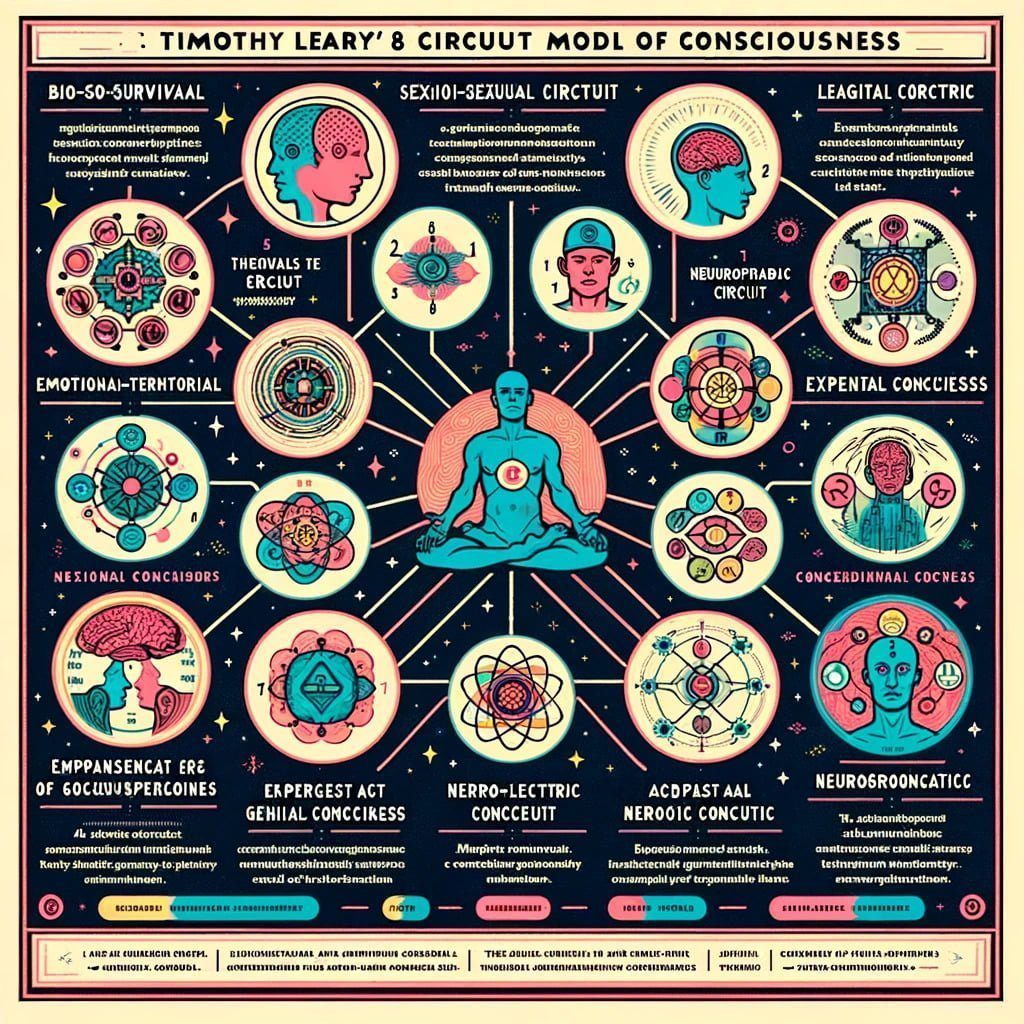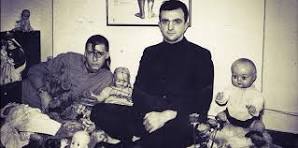
Introduction to Timothy Leary’s 8 Circuit Model of Consciousness
Timothy Leary, a name often synonymous with the psychedelic movement of the 1960s, left behind a legacy that transcends his controversial experiments with LSD. Among his intellectual contributions, the Octave System of Psychological States stands out as a fascinating framework that attempts to map the complexities of human psychology and behavior. This model, which combines elements of neuroscience, psychology, and Eastern spirituality, offers a unique lens through which we can understand the evolution of human consciousness and its potential for growth. This is the psychedelic magick of Dr. Timothy Leary.
Leary’s model is not just a theoretical construct but a practical tool for personal development, suggesting that through understanding and activating these circuits, individuals can unlock new realms of cognitive and emotional capacity. Whether you’re a student of psychology, a seeker of spiritual growth, or simply curious about the frontiers of human consciousness, Leary’s 8-circuit model offers a compelling journey into the mind.
Historical Context of the Octave System of Psychological States
Timothy Leary’s journey into the depths of consciousness was shaped by his experiences as a psychologist, a Harvard professor, and, most notably, his experiments with psychedelic substances. In the 1960s, Leary, along with colleagues like Richard Alpert (later known as Ram Dass), began exploring the therapeutic potential of substances like LSD and psilocybin. These experiences, combined with Leary’s interest in cybernetics, psychology, and Eastern spiritual practices, culminated in the development of the 8 Circuit Level framework..
This model was revolutionary, proposing that the human mind operated on eight distinct levels or “circuits,” each responsible for different aspects of human experience and potential. It was a bold synthesis of scientific knowledge and mystical insight, reflecting the zeitgeist of an era that challenged traditional boundaries and sought deeper understanding of the self and the universe.
Leary’s work, while groundbreaking, was not without controversy. His advocacy for LSD and his mantra of “turn on, tune in, drop out” made him a polarizing figure, admired by some as a visionary and criticized by others as a charlatan. Yet, despite the controversies, the 8 Circuit reference has endured as a fascinating framework for understanding the complexities of the human mind and its untapped potential.
Overview of the 8 Circuits of Consciousness
Timothy Leary’s Model proposes that the human nervous system consists of eight potential circuits of consciousness. Each circuit is responsible for different dimensions of human experience, ranging from basic survival instincts to advanced states of spiritual consciousness. Here’s a brief look at each:
- Bio-Survival Circuit: This circuit is concerned with the basic mechanisms of survival and comfort, including the instinct to seek nourishment and safety.
- Emotional-Territorial Circuit: It deals with emotions, power dynamics, and the establishment of territory and social hierarchies.
- Symbolic-Conceptual Circuit: This circuit encompasses the realm of logic, language, and abstract thought, allowing humans to navigate complex social and technological environments.
- Social-Sexual Circuit: Governing sexual behavior and social bonds, this circuit plays a crucial role in human relationships and cultural norms.
- Neurosomatic Circuit: Associated with heightened states of sensory and emotional awareness, often accessed through meditation or psychedelic experiences.
- Neuroelectric Circuit: This circuit is linked to expanded consciousness, including telepathic and paranormal abilities.
- Neurogenetic Circuit: It involves access to genetic memory and collective unconscious, tapping into ancestral knowledge and archetypes.
- Neuroatomic Circuit: The highest circuit, concerned with quantum consciousness and unity with the cosmos, transcending the physical realm.
Detailed Explanation of the Circuits
Bio-Survival Circuit
The first circuit is the most fundamental, focusing on basic survival needs. It’s activated from birth, governing instincts like feeding, fleeing, and the fight-or-flight response. This circuit is about immediate physical security, comfort, and survival tactics, deeply influencing our approach to life’s challenges and opportunities.
Emotional-Territorial Circuit
Emerging in early childhood, this circuit shapes our emotional responses and social dynamics, including aggression, submission, and the need for dominance in social hierarchies. It’s crucial for understanding group behavior, power structures, and the emotional bonds that tie communities together.
Symbolic-Conceptual Circuit
Developed around the time of language acquisition, this circuit enables abstract thinking, problem-solving, and the use of symbols for communication. It’s the foundation of human culture, technology, and complex social systems, allowing us to plan, theorize, and innovate.
Social-Sexual Circuit
This circuit, coming into prominence with sexual maturity, governs sexual behavior and the nuances of human relationships. It’s pivotal in the formation of social norms, roles, and the emotional complexities involved in human interactions.
Neurosomatic Circuit
Typically activated by experiences of peak performance, meditation, or psychedelic substances, this circuit offers a profound sense of bodily bliss, emotional catharsis, and sensory enhancement. It represents a shift from linear thinking to holistic, body-centered awareness.
Neuroelectric Circuit
The sixth circuit involves expanded consciousness beyond the individual ego, encompassing experiences of telepathy, intuition, and synchronicities. It’s associated with the breakdown of conventional time-space perceptions, leading to a more interconnected sense of reality.
Neurogenetic Circuit
Access to this circuit opens up deep evolutionary memory, linking individuals to the collective experiences and knowledge of their ancestors. It’s a realm of archetypes, genetic wisdom, and a sense of oneness with the life force of all beings.
Neuroatomic Circuit
The final circuit transcends physical reality, tapping into the quantum level of existence. It’s about cosmic consciousness, the dissolution of individual identity into the universal, and the mystical experiences that challenge our understanding of reality itself.
These circuits provide a framework for understanding the layered complexity of human consciousness, suggesting that through various practices, substances, or experiences, individuals can activate and explore these higher states of being. Next, we will explore the Comparative Analysis and delve into the Controversies and Criticisms associated with Leary’s model, offering a broader perspective on its significance and the debates it has sparked.
Comparative Analysis
Timothy Leary’s Model of Consciousness offers a unique perspective on human psychology, contrasting and complementing other models of consciousness. Unlike Freud’s model, which primarily focuses on the unconscious, preconscious, and conscious mind with a strong emphasis on sexual and aggressive drives, Leary’s model spans a broader spectrum of human experience, from basic survival instincts to transcendent states of consciousness. While Freud segmented the psyche into the id, ego, and superego, Leary delineated eight distinct levels, suggesting a more fluid and expansive approach to understanding human consciousness.
Similarly, Carl Jung’s analytical psychology, with its emphasis on the collective unconscious, archetypes, and the process of individuation, shares some conceptual ground with Leary’s higher circuits, especially the Neurogenetic and Neuroatomic circuits. However, Leary’s model incorporates a more explicit focus on the potential for consciousness expansion through practices and substances, aligning it with a more experiential and experimental approach to psychology.
Leary’s model also diverges from traditional behavioral and cognitive models by incorporating elements of Eastern spirituality and psychedelic experiences, areas that were largely unexplored or deemed controversial by mainstream psychology. This integration offers a holistic view that encompasses not only the psychological and emotional aspects of human life but also the spiritual and transcendental dimensions.

Controversies and Criticisms
Timothy Leary’s work has not been without its controversies and criticisms. Critics argue that Leary’s enthusiastic advocacy for psychedelic drugs overshadowed the scientific rigor of his work, leading to a dismissal of his theories by the broader psychological community. Some have criticized the model for its speculative nature, lack of empirical evidence, and reliance on subjective experiences that are difficult to quantify or replicate in controlled settings.
Additionally, Leary’s model has been critiqued for its potential to oversimplify or misrepresent the complexities of human psychology and consciousness. Skeptics question the universality of the eight circuits, suggesting that human experience cannot be neatly categorized into such a framework. The model’s focus on drug-induced states of consciousness also raises ethical and health concerns, with critics cautioning against the glorification of substance use as a means of achieving personal growth or enlightenment.
Despite these criticisms, Leary’s model has also been praised for its innovative approach to understanding consciousness and its potential for personal transformation. It has inspired further research and exploration into the nature of consciousness, including the study of psychedelics, meditation, and alternative states of mind. The model’s holistic and expansive view of human potential continues to resonate with those seeking to explore the outer limits of consciousness and the inner depths of the psyche.
Modern Applications and Legacy of Psychedelic Magick
The 8 Circuit Model of Consciousness, despite its controversies, has left a lasting impact on various fields, including psychology, philosophy, and the burgeoning study of consciousness. Its influence can be seen in the continued interest in psychedelic research, with contemporary studies exploring the therapeutic potential of psychedelics for treating mental health disorders such as depression, PTSD, and anxiety. Leary’s model also finds resonance in the field of transpersonal psychology, which integrates spiritual and transcultural dimensions of human experience into psychological theory and practice.
Moreover, the model has inspired artists, writers, and thinkers seeking to explore the interplay between consciousness, culture, and creativity. Its conceptual framework has been applied in workshops, self-help books, and spiritual practices aimed at personal development and self-exploration.
As we continue to expand our understanding of the mind and its capabilities, Leary’s 8 Circuit model of consciousness serves as a provocative and challenging framework that encourages us to question conventional wisdom and explore the vast, uncharted territories of human consciousness.
Conclusion
Timothy Leary’s 8 Circuits is one of the most intriguing and controversial contributions to the field of psychology and the study of consciousness. It challenges us to consider the depths of human potential, from the basic instincts that drive us to the transcendental experiences that define our highest aspirations. While not without its criticisms, the model provides a comprehensive framework for exploring the complexities of the human mind and the myriad ways in which we perceive and interact with the world around us.
In an era where the exploration of consciousness is gaining renewed interest and legitimacy, Leary’s work invites us to reconsider the boundaries of psychological inquiry and the potential for personal and collective transformation. As we venture further into the mysteries of the mind, the 8 Circuit Model of Consciousness offers a roadmap for understanding the infinite nuances and possibilities of human experience, encouraging us to explore, experiment, and expand our conception of what it means to be conscious beings in an ever-evolving universe. This is psychedelic magick.


